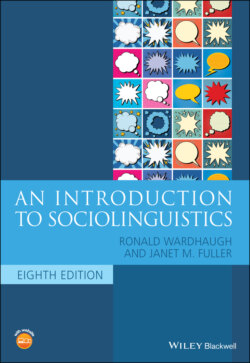Читать книгу An Introduction to Sociolinguistics - Ronald Wardhaugh, Janet M. Fuller - Страница 15
The Nature of Language
ОглавлениеA mainstay of introduction to linguistics textbooks (see for example Yule 2017) is a discussion of the nature of language and, often, how it differs from animal communication. Although the human ability to learn language is innate, a person learns a language through contact with others and thus language is culturally transmitted – an idea which is at the heart of sociolinguistics. Other features include discreteness, productivity, and displacement, which can be used to distinguish between non‐linguistic means of communication such as gestures and language. Another important feature is that the relationship between the form and meaning of a linguistic sign is arbitrary; aside from a few onomatopoetic words, such as words for animal sounds (e.g., meow, moo), the form (including both the sound and the way it might be written) of a morpheme is not derived from its meaning, or vice versa. We see evidence for the arbitrariness of the form–meaning relationship in the presence of synonyms within languages (e.g., sofa, couch) as well as the fact that words from different languages may have drastically different forms but still have the same meaning (e.g., English love, Swahili kupenda).
By examining how language works in its social context, sociolinguistics has greatly advanced our understanding of the relationship between signs and their meanings. The philosopher Peirce (Hartshorne et al.1931) suggested a three‐way typology of signs. A symbol is a sign which has developed a conventional meaning; for example, a heart shape indicates love. There is nothing about this shape which inherently leads to this interpretation; it is simply a correspondence which has grown out of use. As noted above, linguistic signs are generally symbols, that is, we understand them because of conventionalized meanings, not because of any ‘natural’ connection between the sign and its meaning. An icon is a sign which in some way resembles the object it refers to, such as a map. Although linguistic signs are not generally held to be iconic, particular varieties may be seen as having an iconic relationship with the people who use them (see chapter 3 for a discussion of this in the section on language ideologies). An index is something which ‘points to’ something – such as literal pointing with your finger to indicate what you are referring to, or the commonly used example of smoke indexing fire. Smoke does not resemble fire, but since the two often co‐occur, we associate them with each other (as shown in the idiom ‘when there’s smoke there’s fire’). The concept of indexicality is one which has drawn great interest in sociolinguistics. Put simply, certain varieties often come to index certain types of language users; thus indexicality is inherently a central aspect of the study of language in society. We will expand on the use of this concept in sociolinguistics in the next chapter.
